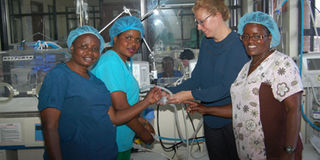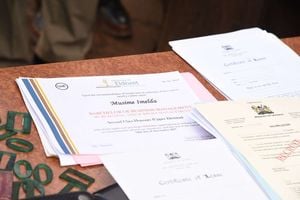American doctor trains Nakuru nurses to manage respiratory defects in babies

Nurses Catherine Ngina, Wilder Juma (left) and Peris Mwangi (right) and Dr Nora Switchenko, an American neonatal paediatrician at Margaret Kenyatta Mother Baby Wing at Nakuru Level Five Hospital on September 4, 2019. The American doctor trains nurses how to use the bubble Continuous Positive Airway Pressure machine that helps newborns with respiratory disorders. PHOTO | FRANCIS MUREITHI |NATION MEDIA GROUP
What you need to know:
The bubble CPAP delivery system is a non-invasive ventilation strategy for newborns with infant respiratory distress syndrome.
Dr Switchenko says babies with respiratory problems are born with underdeveloped lungs and the CPAP device helps open their lungs.
As she steps into the ultra-modern Margaret Kenyatta Mother Baby Wing at the Nakuru Level Five Hospital, Dr Nora Switchenko could easily pass for a foreign visitor who is in the facility to donate gifts to newly born babies.
The American doctor warmly exchanges pleasantries with patients, subordinate staff and nurses at the hospital.
But Dr Switchenko is not an average visitor at the referral hospital that delivers more than 1,200 babies monthly.
PAEDIATRICIAN
The 35-year-old is a neonatal paediatrician from Uttah State the US.
“I am here to train nurses on a special technology dubbed bubble Continuous Positive Airway Pressure (CPAP) to improve the care of newly born babies with respiratory problems," says Dr Switchenko.
The bubble CPAP delivery system is a non-invasive ventilation strategy for newborns with infant respiratory distress syndrome.
It is one of the methods by which continuous positive airway pressure is delivered to a spontaneously breathing newborn to maintain lung volumes during respiration.
Dr Switchenko says that babies with respiratory problems are born with underdeveloped lungs and the CPAP device helps them keep their lungs open for delivery of oxygen.
Her training is paying dividends as the new device is increasingly becoming the life-saving machine that nurses use to resuscitate babies with respiratory disorders.
RESPIRATORY DIFFICULTIES
The new system offers safe, efficient and cost-effective treatment of respiratory difficulties in neonates. Mothers can now walk home smiling as they cuddle their babies.
“Underweight babies are coping well, thanks to the CPAP technology,” she explained.
The youthful doctor who works at the Intensive Care Unit back at home is now a symbol of hope to many mothers who deliver underweight babies with respiratory distress.
Dr Switchenko knows how it feels to see a baby on CPAP machine since her first born daughter weighed 1.2 kilograms and was put on CPAP machine.
“I know what mothers go through. I was terrified when I gave birth to an underweight baby. She had tubes wrapped around her face while some were sticking out of her tummy,” said Dr Switchenko.
“The baby brings immense joy to me. She inspires me to make that possible for all underweight babies to grow healthy,” she added.
Dr Switchenko has put in 10 years in medical studies.
SPACIALISED TRAINING
She studied for four years at Oregon Health Science University and did three years as residence paediatrician before taking a three-year specialised training in neonatology at University of Uttah.
“I can’t imagine of a better patient than a baby, I enjoy taking care of the babies because I want to give them the best start in life journey,” said Dr Switchenko.
She says working as neonatal paediatrician has made her the best person she can ever imagine in the field of medicine.
She describes the nurses in Nakuru as spectacular as they are easily identifying babies that need help.
“The nurses here have developed a hawk-eye, identifying babies who need special attention immediately after birth. They are doing a great job, their resilience is amazing,” said Dr Switchenko.
Ms Wilder Juma, a nurse at new born unit, says she has learnt a lot from Dr Switchenko.
“She has taught me how to handle the machine and this is knowledge that I did not get at the nursing school,” she said.
Ms Catherine Ngina says she has mastered the use of CPAP machine.
CPAP MACHINE
“I can handle a baby with respiratory problems. I know it is possible to save that life with the CPAP machine,” said Ms Ngina.
Ms Peris Mwangi said that the training comes at a time when the hospital is witnessing an increased number of expectant mothers from neighbouring counties.
“I am now well prepared to handle babies with respiratory challenges,” said Ms Mwangi.
Dr Switchenko says the workload is quite enormous.
“The spirit of never giving up to save life of tiny babies by these wonderful and hardworking nurses is something that keeps me going,” she added.
She says her mission is to ensure the nurses grasp the operation of CPAP and help babies thrive while on the machine.
She says some of the most rewarding aspects working as a neonatal paediatrician is helping a baby overcome breathing distress.
“When the mother takes over the baby from the CPAP machine and leaves the hospital smiling, that makes me happy,” she said.
However, like any medical field, she has encountered challenges.
MEMORABLE MOMENT
“One of the biggest challenge is to come to work with the same spirit and hope and continue making the system better when a baby dies.
She says when the pain of managing a sick baby is overwhelming, she relies on the great team of nurses she works with.
“The people who work in new born unit become a family and support each other in hard times,” she says.
She says her most memorable moment working in Nakuru is when she sees nurses embrace the CPAP technology.
“I am proud to be part of the team that has made this technology work in Nakuru.”
She advises students who are interested in becoming neonatologists to prepare well.
“They must be ready to work hard and examine as many babies as possible when they are in new born unit,” she added.
She says a better doctor understands the team he or she is work with. She says to improve health services in Kenya, more nurses and doctors must be employed.
“The successful treatment of a patient is not a one-man show, it is a collective responsibility of the entire team,” she concludes.





